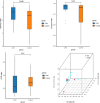Amniotic fluid microbiota and metabolism with non-syndromic congenital heart defects: a multi-omics analysis
- PMID: 39922995
- PMCID: PMC11806881
- DOI: 10.1186/s12884-025-07218-7
Amniotic fluid microbiota and metabolism with non-syndromic congenital heart defects: a multi-omics analysis
Abstract
Background and aims: Recent studies have indicated possible links between the microbiota and the fetal heart, while the relevant mechanism is still unknown. This study is aims to investigate whether analyzing the microbiota and metabolic profiles of amniotic fluid collected from pregnant women whose fetuses with or without non-syndromic congenital heart defects (CHDs), during the second and third trimester of pregnancy, could offer valuable insights into CHDs.
Methods and results: A case-control study was conducted with 17 cases diagnosed with non-syndromic CHDs (CHDs group) and 34 controls without congenital anomalies (control group) at a ratio of 1:2. The 16 S rDNA gene sequencing and metabolomics methods were employed to assess 51 amniotic fluid samples. The amniotic fluid microbiome from the CHDs group exhibited significantly higher Shannon and Simpson indices compared to the control group. At the genus level, 240 bacterial taxa were substantially enriched in the two groups, with 93 of those taxa being highly enriched in the case group. Compared to the control group, the case group exhibited 177 metabolites that were significantly increased and 480 metabolites that were down-regulated. The differential metabolites were primarily enriched in the steroid hormone biosynthesis, bile secretion and ovarian steroidogenesis, according to KEGG analysis. The observed variations in nine metabolites could attributed to fifty-eight distinct bacterial taxa. The nine differential metabolites were mainly associated with pathways involving steroid hormone biosynthesis, bile secretion, glycolysis, tricarboxylic acid (TCA) cycle, NADPH metabolism, and acyl transfer pathways.
Conclusion: The CHDs group has disturbed amniotic fluid microbiota and metabolites, and more research was required to elucidate the mechanism.
Keywords: Birth development; Congenital heart defects; Metabolite; Microbiota; Multiomics analysis.
© 2025. The Author(s).
Conflict of interest statement
Declarations. Ethics approval and consent to participate: The program was approved by the Ethics Committee of Sichuan University (No. 2010004) and West China Second University Hospital (No. 2015(011)). All subjects provided informed consent during the enrollment process. Consent for publication: The work has not been published elsewhere and does not contain any content that infringes upon the rights of others, including copyright or privacy rights. The author understand that once published, the work will be publicly accessible. Clinical trial number: Not applicable. Competing interests: The authors declare no competing interests.
Figures




Similar articles
-
Biomarkers for isolated congenital heart disease based on maternal amniotic fluid metabolomics analysis.BMC Cardiovasc Disord. 2022 Nov 20;22(1):495. doi: 10.1186/s12872-022-02912-2. BMC Cardiovasc Disord. 2022. PMID: 36404327 Free PMC article.
-
Alterations in maternal-fetal gut and amniotic fluid microbiota associated with fetal growth restriction.BMC Pregnancy Childbirth. 2024 Nov 8;24(1):728. doi: 10.1186/s12884-024-06930-0. BMC Pregnancy Childbirth. 2024. PMID: 39516719 Free PMC article.
-
RNA-Seq of amniotic fluid cell-free RNA: a discovery phase study of the pathophysiology of congenital cytomegalovirus infection.Am J Obstet Gynecol. 2022 Oct;227(4):634.e1-634.e12. doi: 10.1016/j.ajog.2022.05.035. Epub 2022 May 21. Am J Obstet Gynecol. 2022. PMID: 35609640 Free PMC article.
-
Biomarkers for congenital ventricular outflow tract malformations based on maternal serum lipid metabolomics analysis.BMC Pregnancy Childbirth. 2024 Aug 20;24(1):547. doi: 10.1186/s12884-024-06738-y. BMC Pregnancy Childbirth. 2024. PMID: 39164614 Free PMC article.
-
Serum and Amniotic Fluid Metabolic Profile Changes in Response to Gestational Diabetes Mellitus and the Association with Maternal-Fetal Outcomes.Nutrients. 2021 Oct 18;13(10):3644. doi: 10.3390/nu13103644. Nutrients. 2021. PMID: 34684645 Free PMC article.
References
-
- van der Linde D, et al. Birth prevalence of congenital heart disease worldwide: a systematic review and meta-analysis. J Am Coll Cardiol. 2011;58:2241–7. - PubMed
-
- Bernier PL, Stefanescu A, Samoukovic G, Tchervenkov CI. The challenge of congenital heart disease worldwide: epidemiologic and demographic facts. Semin Thorac Cardiovasc Surg Pediatr Card Surg Annu. 2010;13:26–34. - PubMed
-
- EUROCAT:. European Surveillance of Congenital Anolmalies. (www.eurocat- network.eu).
-
- Zhao QM, et al. Prevalence of congenital heart disease at live birth in China. J Pediatr. 2019;204:53–8. - PubMed
-
- Jerves T, Beaton A, Kruszka P. The genetic workup for structural congenital heart disease. Am J Med Genet C. 2020;184:178–86. - PubMed
MeSH terms
Grants and funding
- 2023NSFSC1642/the National Natural Science Foundation of Sichuan Province for Young Scholars
- 2014FY110700/the Special Project for Basic Work of Science & Technology
- 82103858/the National Natural Science Foundation of China
- 2021YJ0212/the Applied Basic Research Program of Sichuan Province
- 21PJ057/the Popularization Application Project of Sichuan Province
LinkOut - more resources
Full Text Sources
Medical

